
A Guide to the Amphibians
and Reptiles of California

New Species of California Amphibians and Reptiles
That are Currently Not Officially Described
and
Existing Species that Might Inhabit California

Currently Undescribed Amphibians and Reptiles Found in California |
|
|
|
Salamanders |
|
| Batrachoseps sp. - Borrego Slender Salamander |
Hansen and Shedd describe a large pale slender salamander with long limbs, large feet, and a short trunk that was discovered in a few sites after the unusually wet 2003 winter in foothills south of Borrego Springs, about 20 miles (32 km) south of the nearest population of the Desert Slender Salamander. The landscape is arid boulder-strewn Colorado Desert scrub. The taxonomic status of this salamander is under study. Pictures of salamanders can be found on page 254. (Robert W. Hansen and Jackson D. Shedd. California Amphibians and Reptiles, 2025 p. 62.) You can also see a juvenile and a large pale adult in this YouTube herping video, beginning at 4:18. |
| Batrachoseps sp. - Peninsula Slender Salamander |
Hansen and Shedd describe an undescribed species of slender salamander known from only a few specimens found at two sites in desert foothills with enormous granite boulders in extreme southwestern Imperial County just north of the border with Mexico near Valley of the Moon. They speculate that it is likely the northern terminus for a species whose distribution continues south into Baja California. The salamander was first collected in 1976, with a specimen in the San Diego Natural History Museum collection showing the location as "Moon Valley." No more specimens were found until the unusually wet winter of 2023. The taxonomic status of this salamander is under study. Pictures of salamanders can be found on page 254. (Robert W. Hansen and Jackson D. Shedd. California Amphibians and Reptiles, 2025 pp. 62-63.) |
| Santa Cruz Cave Salamanders Dicamptodon ensatus - California Giant Salamander |
UC Santa Cruz biologist Barry Sinervo discovered and studied a paedomorphic form of California Giant Salamander that is found in a system of caves in Santa Cruz County. These aquatic salamanders are all patternless and grey in coloration, possibly from consuming food in the cave that has no pigment. (A cave salamander fed pigmented food in the laboratory became darker in color.) Sinervo and his students collected larval salamanders from inside the cave and just outside the cave, then raised them in captivity. The cave salamanders stayed in the aquatic phase while 19 of 20 salamanders from outside the cave transformed into the terrestrial phase. (Cope's Giant Salamander - Dicamptodon copei, is a similar species that is also fixed on the paedomorphic form.) In a letter dated January 2006, Sinervo says that it is likely that these salamanders represent a genetically distinct population segment that is different from surface populations just outside the cave. He needs to analyze the DNA of more salamanders in order to determine how distinct they are, but due to the drought present before 2016 which caused no water to flow into the caves, specimens have not been available. Protecting the unique environment in the caves should be a priority until the lineage of the salamanders can be determined. Articles about this population have been published in a number of Santa Cruz sources, including the Santa Cruz Sentinel in 2006, which is apparently no longer online, and those listed below, but none have ever shown a picture of the salamanders. Daily Breeze article 3/7/16 Hilltromper Santa Cruz article 1/21/16 You can see pictures of one of these salamanders and others just outside the cave on my Dicamptodon ensatus page. |
| Hydromantes sp. - Castle Crags Salamander |
David Haynes CDFW, 2020: PDF Download "... new observation of Shasta salamander was documented at Castle Crags in April 2019. The observation was at an approximate elevation of 5000 feet. The specimen appeared to have morphological characteristics that were not typical of H. shastae, H. wintu, or H. samweli. (did not contain lateral dark bands on either side of torso), and could potentially be a local range expansion for Shasta salamander. Presence/absence surveys around Castle Crags would be highly recommended to collect more population data in this area." This species has not been formally described or named yet, so I have not added it to the state list, but it is covered extensively in Robert W. Hansen and Jackson Shedd California Amphibians and Reptiles, 2025 p. 69. |
| Hydromantes sp. - Millerton Cave Salamander 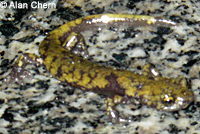 Juvenile © Alan Chern |
In September of 2015 I was contacted by G.O. Graening, who was co-writing the book "The Cave Fauna of California" (PDF Download) to help him identify a salamander found by caver Alan Chern in Millerton Lake Cave in Fresno County. It appeared to be a juvenile Hydromantes in an area where they were not known to occur, so I contacted herpetologist Robert Hansen and he led the research that led to the discovery that it might be a unique taxa. As far as I know, a description of the salamander was first documented about nine years later in Robert W. Hansen and Jackson D. Shedd California Amphibians and Reptiles, 2025 p. 67. The species has not been formally described and named yet, so I have not added it to the state list, but it is covered thoroughly in the book, including a picture of a juvenile and several pictures of adult salamanders, which are not as colorful as the juvenile shown here. There is also a taxonomic note in the book about the salamander: "The taxonomic status of the recently discovered Millerton Cave Salamander (Hydromantes sp.) is unresolved. This form differs from its nearest relative, H. platycephalus, in morphology and ecology, and it is geographically isolated. However, unpublished genetic studies recovered that this population is deeply nested within the southern lineage of H. platycephalus, reflecting recent divergence."  Red: Hydromantes platycephalus - Mount Lyell Salamander Bright Blue: Hydromantes brunus - Limestone Salamander Bright Green: Hydromantes sp. - Millerton Cave Salamander |
| Hydromantes sp. - Owens Valley Web-toed Salamander (AKA Oak Creek salamander) (Currently recognized here as Hydromantes platycephalus)  |
Although Hydromantes salamanders from the eastern slopes of the Sierra Nevada Mountains are currently grouped with Hydromantes platycephalus, they differ in color and habitat. In 1985, Macy and Papenfuss identified what they believed to be a new species of Hydromantes on the "Eastern slopes of the Sierra Nevada at least from the area around Owens Lake to Big Pine" which they named the Owens Valley Web-toed Salamander. Macey, J. Robert and Theodore Papenfuss."Herpetology." The Natural History of the White-Inyo Range Eastern California. Ed. Clarence Hall. University of California Press, 1991. |
| Snakes | |
| Crotalus oreganus ssp. - Catalina Island Rattlesnake 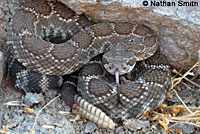 © Nathan Smith |
Some naturalists believe that rattlesnakes on Santa Catalina Island are distinct from those on the mainland and will be recognized as a different subspecies once DNA studies are completed. You can see more pictures of them here. LA Times Article 11/28/09 |
Crotalus oreganus ssp. - "Carrizo Yellow" form © John Sullivan |
According to Todd Battey, author of SoCal Herps, an electronic field guide to the reptiles and amphibians of Southern California, Northern Pacific Rattlesnakes that occur from the Carrizo Plains south along the western side of the San Joaquin Valley differ from others of the subspecies in having a yellow dorsal coloration, a large dose of mojave toxin in the venom, and fewer large scales between the supraoculars. This form is called the "Carrizo Yellow" form and may be distinct enough to be considered a separate subspecies. |
| Crotalus (Sayersus) funki sp. nov. Crotalus helleri idyllwildi subsp. nov. |
In August 2016 Raymond Hoser published a description of two new forms of rattlesnakes found in California referencing a study by Pook et al (2000): "Pook et al. (2000) also produced evidence to show significant lineages that warranted taxonomic recognition, including central Californian C. oreganus Holbrook, 1840 and a population of C. helleri from California, distinct from both nominate C. helleri and C. callignis. However in the sixteen years that have elapsed since that study, neither taxon has been formally named." Both of these taxa are probably just regional variants that do not warrant any special treatment. Below are excerpts from the descriptions. The full descriptions can be read online here. Crotalus (Sayersus) funki sp. nov. This species has been "...treated as a regional variant of C. oreganus. It is readily distinguished from that species by the presence of a distinct whiteish-yellow band or stripe running across the head between eyes and distinct black borders of the darker brown dorsal body blotches, versus neither in C. oreganus, or at best only indistinct for one or other or both traits." "Distribution: The general area from San Francisco and Alameda County California in the north, along the coastal strip, including nearby hills to south of San Louis Obispo County, California, USA, in a broad swathe covering most of the southern Coast Ranges, with the possible exception of the far southernmost areas, where C. helleri occurs. The distribution of this taxon is bounded by the allopatric distribution of C. oreganus to the north and C. helleri to the south and broadly mirrors that of putative nominate Elgaria multicarinata multicarinata (Blainville, 1835)." Crotalus helleri idyllwildi subsp. nov. This subspecies "...is readily separated from other C. helleri by the very dark brownish-grey pattern on the dorsum, broken with very distinctive narrow light yellowish-white markings, forming a somewhat reticulated pattern. By contrast, normal C. helleri helleri (or C. helleri callignis) from elsewhere are characterised by a much lighter overall colouration consisting of a yellowish brown colouration on the upper body, punctuated with large and irregular dark brown blotches running along the midline. Rarely dark C. helleri helleri do occur, but these are characterised by dark colouration all over, as opposed to having the bright markings on the darker body background as seen in C. helleri idyllwildi subsp. nov.." This subspecies is known only from the hills around Idyllwyld on Mount San Jacinto, Riverside County, California. Hoser is an Australian herpetologist whose work is so controversial that, according to Wikipedia (accessed 12/8/16), "In 2013 a group of international herpetologists published a paper in the Herpetological Review, a peer-reviewed publication of the Society for the Study of Amphibians and Reptiles. The paper, which included the names of over 60 of the world's academic herpetologists as supporters, and many of the major societies including the World Congress of Herpetology, set out to put a stop to the 'taxonomic vandalism' of Hoser and another self-publishing herpetologist, Richard Wells. It dismissed as unscientific, and lacking in evidence, scientific rigor, or credibility, the huge number of names coined by Hoser since 2000, mostly in his self-published, self-edited, single-authored Australasian Journal of Herpetology, and provided authors with the original or alternative, more acceptable, names. The paper also dealt with a smaller number of names coined by Wells." ... "In 2013, the British Herpetological Society and the Netherlands Association for Herpetoculture adopted resolutions censuring Hoser for naming reptiles without scientific evidence or peer review and what they deemed as 'vanity publishing.' " (New Rattlesnakes in the Crotalus viridis Rafinesque, 1818 and the Uropsophus triseriatus Wagler, 1830 species groups (Squamata:Serpentes:Viperidae:Crotalinae). RAYMOND T. HOSER Australasian Journal of Herpetology 33:34-41. ISSN 1836-5698 (Print) Published 1 August 2016.) |
| Thamnophis hammondii ssp. - Santa Catalina Garter Snake  Adult, Santa Barbara County © Brian Hubbs |
Two-striped Gartersnakes - Thamnophis hammondii, that inhabit Santa Catalina Island have been classified as a separate subspecies by some researchers, but recognition of this subspecies is not common. "...the garter snakes on Santa Catalina Island look very different from mainland two-striped garters. Actually, the name "two-striped,'' which has been applied to the subspecies hammondi, is totally inappropriate for island specimens, which lack any markings whatever. Instead, they are a uniform olive-brown on top; their undersides are also olive-brown, but slightly clouded with orange. Only their chins, lip scales, and throats are pale olive-buff. By. contrast, most mainland specimens are blackish-brown on top with a well-defined yellow stripe along each side. Their lips, chins, and undersides are usually buff-yellow, Occasionally, a dark mainland snake can be found which approaches the coloration of the island specimens, but this is atypical. Aside from coloration, island and mainland forms seem basically alike. Meristics of the Santa Catalina examples fall within the range of hammondi as a whole." Summary "For 33 years, only two specimens of the garter snake (Thamnophis couchi hammondi) were recorded for Santa Catalina Island and the status of this species remained unknown. In August 1974, a small population was discovered in the stream and reservoir in Cottonwood Canyon. The species apparently occurs nowhere else on the island. Unlike most two-striped mainland specimens, garter snakes on Santa Catalina lack any pattern, being a uniform olive-brown with pale buff lips and chins. In this respect they most closely resemble a different species from central Baja California and a conspecific population near Lompoc on the California mainland. The ecology of Cottonwood and other stream canyons on Santa Catalina is discussed, as are human impacts on garter snakes, and recommendations for conservation measures. Finally, rafting is proposed as a mechanism by which garter snakes from the Lompoc region might have founded the population on Santa Catalina Island." Brown, Timothy W. The Present Status of the Garter Snake on Santa Catalina Island, California. In: 2nd California Islands Multidisciplinary Symposium. 1978. 585-595. |
| Thamnophis sirtalis ssp. - South Coast garter snake  © Eli Short |
Southern California populations of T. sirtalis along the coastal plain from Ventura County to San Diego County might be recognized as a distinct taxon, the South Coast Gartersnake, pending an official published description. The The State of California has designated Common Gartersnake populations along the coastal plain from Ventura County to San Diego County as a Species of Special Concern. These snakes are listed as a subspecies of Common Gartersnake -Thamnophis sirtalis, on the California Department of Fish and Wildlife's Special Animals List: T. sirtalis ssp. - south coast gartersnake (Coastal plain from Ventura Co. to San Diego Co., from sea level to about 850 m). More information and pictures can be found on our South Coast Gartersnake page found at the link to the left. |
| Lizards | |
| Xantusia sp. Fish Creek Mountains Night Lizard |
"A population of night lizards recently discovered in the San Felipe Creek drainage (Fish Creek Mts., Imperial County) just southwest of the Salton Sea and ca. 25 mi./40 km south of Truckhaven Rocks [where Xantusia gracilis is found] is of uncertain affinity...." This could be a range extension for X. gracilis or an outlier for X. henshawi, or it could be a new species. Robert W. Hansen and Jackson D. Shedd in California Amphibians and Reptiles, 2025 p. 177. |
| Species of Amphibians and Reptiles Found Near the California Border that Might Inhabit California but Remain Unconfirmed |
|
It has been speculated that the following species of reptiles and amphibians might occur within the state boundaries of California, but their presence has not been confirmed or they need taxonomic analysis or the species or subspecies is not confirmed. None of these is on our California list yet. Also see our page of Non-native Reptiles and Amphibians Introduced Into California which includes some unconfirmed introduced species. |
|
| Snakes | |
| Chilomeniscus cinctus - Banded Sandsnake  |
The strong possibility of this snake turning up in suitable habitat west of the Colorado River where it occurs in Arizona and Baja California, and undocumented reports of the snake in California have led me to include this snake as possibly occurring in Calfiornia. You can read more about this in the comments on the page in the link to the left which was made when this snake was on my official list of California snakes. |
| Crotalus molossus - Western Black-tailed Rattlesnake 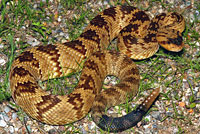 |
This rattlesnake is found east of California in Arizona. "Potential habitat is present in CA west of the Colorado River in the Chocolate, Big Maria, Palo Verde, Riverside, and Whipple Mts of Imperial and Riverside counties. Collectively, these areas are relatively underexplored for herpetofauna." (Robert W. Hansen and Jackson D. Shedd. California Amphibians and Reptiles, 2025 p. 231.) |
Micruroides euryxanthus - Sonoran Coral Snake |
"A snake of the Sonoran Desert in the U.S. and northwestern Mexico. Has been found in desert foothills of southwestern AZ, in La Paz and Yuma counties. One of these records was only 9 mi./14.5 km from the CA border. Searches should be made in various desert ranges of eastern Imperial and Riverside counties." (Robert W. Hansen and Jackson D. Shedd. California Amphibians and Reptiles, 2025. p. 231) |
| Thamnophis eques - Mexican Gartersnake |
"This species' range lies mostly in Mexico but extends into southern AZ and NM. Based on old records from Fort Mohave and Yuma (both apparently on the NV or AZ side of the river, respectively), it historically reached the Colorado River. Two recent finds in western AZ are of great interest. One of these was at the Havasu National Wildlife Refuge (Mohave Co.), only 1.3 mi./2.1 km from the CA border. This wetland complex extends to the Colorado River, and it is possible that Mexican Gartersnakes still occur in CA or at least did so historically." (Robert W. Hansen and Jackson D. Shedd. California Amphibians and Reptiles, 2025 pp. 231-232) |
| Lizards | |
| Callisaurus draconoides myurus - Northern Zebra-tailed Lizard  |
This subspecies of Callisaurus draconoides (which is not recognized by everyone) occurs in Nevada not far from the California border north of Honey Lake, where it might occur in washes along the border near Smoke Creek. |
| Crotaphytus grismeri - Grismer's Collared Lizard |
Also known as Sierra los Cucapas collared lizard and el cachorón de Sierra de los Cucapas. Because this species closely resembles the Baja California Collared Lizard (Crotaphytus vestigium) and could be confused for this species if seen in California, and because it inhabits mountains in Baja California, Mexico, just south of the California border with contiguous elevated rocky terrain in California, Hansen and Shedd speculate that the species might be found just north of the border in southern Imperial County. (Robert W. Hansen and Jackson D. Shedd in California Amphibians and Reptiles, 2025 p. 230-231) |
| Frogs | |
| Anaxyrus Nelsoni - Amargosa Toad 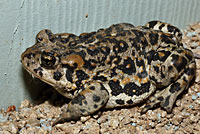 |
"Bufo boreas nelsoni - Stejneger - Nevada Toad" was listed as "recorded from Resting Springs, Inyo County, in a list of Amphibians and Reptiles in California published in 1917. (Joseph Brinnell and Charles Lewis Camp. A Distributional List of the Amphibians and Reptiles of California. University of California Publications in Zoology Vol. 17, No. 10, pp. 127-208. July 11, 1917) More pictures |
Anaxyrus woodhousii australis - Southwestern Woodhouse's Toad  |
Some authors* show that the toads inhabiting the southern part of the state are this subspecies, not A. w. woodhousii, as we show on this web site, and they show that the toads inhabiting the area near the Nevada border are A. w. woodhousii. Old museum records that show subspecies information with the records list the southern populations as A. w. woodhousii, but some recent research analyzing advertisement call variation ** has indicated that the southern California toads are more closely related to those in south-central Arizona, which are A. w. australis. * Bartlett, R. D. & Patricia P. Bartlett. Guide and Reference to the Amphibians of Western North America (North of Mexico) and Hawaii. University Press of Florida, 2009. ** Brian K. Sullivan, Keith B. Malmos, Mac F. Given. Systematics of the Bufo woodhousii Complex (Anura: Bufonidae): Advertisement Call Variation. Copeia, Vol. 1996, No. 2 (May 16, 1996), pp. 274-280 More pictures |
| Turtles | |
| Kinosternon flavescens - Yellow Mud Turtle  |
The Yellow Mud Turtle "...has been reported at Yuma, Arizona, and can be expected in California along lower Colorado River." (Robert Stebbins. California Amphibians and Reptiles. 1972. p. 142) (More pictures Here) |
| Amphibian and Reptile Rumors * Unconfirmed Sightings * Unsolved Mysteries | |
These are some of the rumors that I have come across regarding new and undescribed herps from around the state or sightings of known species in areas where they are not known to occur. Some involve old discoveries that were never identified, others are just speculation about what should or could appear in a certain spot based on rumors of undocumented finds, or hunches, or just crazy speculation. Please email me if you know of any other interesting California herp rumors. |
|
| Snakes | |
| Charina umbratica - Southern Rubber Boa 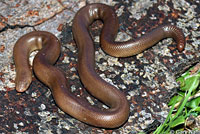 |
There is a lot of speculation that this species should occur in the San Gabriel Mountains, since it occurs east of them in the San Bernardino Mountains and west of them in the Mt. Pinos area, with a large gap in-between. Since the San Gabriel Mountains have been extensively surveyed, it is not likely rubber boas are found in them, but not impossible. After all, it was not until the early 1990's that a new species of salamander was discovered in several locations in the San Gabriels. There is a slim possibility that the boa is there but has gone undetected. There is a specimen in the San Diego Natural History Museum (19332) that was collected on the road at Bouquet Reservoir in 1958, but by an examination of body length and scale counts it was determined to have been a snake that originated in the Sierra Nevada and was probably released. (The dorsal scale count was higher than the maximum for any of the dwarf boas in the transverse ranges and the body was estimated to be longer than the maximum length.) The habitat in that area is also dryer than preferred by the species and the elevation of around 3,000 ft. is lower than would be expected. (R. Hoyer) |
| Charina bottae - Northern Rubber Boa  |
There is a large gap in the documented range of this species along the central coast between southern Monterey County and and the Mt. Pinos area, except for a locality in Montana De Oro in San Luis Obispo County, and photo vouchers of its existence there were only made in 2008. There is reason to believe it occurs in these ares, including suitable habitat and anecdotal evidence, but no other specimens or vouchers have been documented yet. |
| Lampropeltis zonata - California Mountain Kingsnake 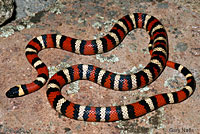 Lampropeltis pyromelana  |
White Mountains Rumors and theories have been around on the internet for a while regarding a mountain kingsnake that was found in the White Mountains. In 2006 I heard that there were 3 specimens found there that looked like snakes from the Sierra Nevada mountains. I haven't yet seen any published information about this, but I might have missed it. If you know of anything and can send it to me, please do so. (I have also read rumors that there could be Lampropeltis pyromelana in the White Mountains.) Santa Catalina Island The previously-uncertain presence of Lampropeltis zonata on Santa Catalina Island was confirmed when an Island Fox was videotaped preying on a California Mountain Kingsnake on Catalina Island on April 26th, 2015. A still photo was posted on Facebook and might still be available. (Robert W. Hansen, Richard Cazares, & Alexus Cazares. Herpetological Review 46(4), 2015) |
| Worm Lizards | |
Bipes |
William Flaxington, author of "Amphibians and Reptiles of California: Field Observations, Distribution, and Natural History" sent me an amusing Herp Review article from 1981** that contains a discussion of "...more than a dozen historical accounts given orally in 1877 by Jose Francisco Palomares, an early pioneer in California, and recorded by the historian Thomas Savage (Temple, 1955)." The article estimates that the incidents probably occured some time in the 1820s. One of Palomares' accounts describes an incident where a Native American man named Ygnacio died as the result of an "ajolote" which is a colloquial term for a worm lizard (known as Bipes in Baja California) a small elongated snake-like or worm-like animal with two short front legs with clawed fingers. Worm lizards, according to Mexican mythology, will burrow into the rectum of a person who is lying or sitting on the ground or who has their pants pulled down with their anus exposed, ready to defecate. Palomares' story is based on this mythology. (This myth has continued into the present day. It was told to me in 2001 in Baja California Sur when I was looking for Bipes.) Ygnacio was heard crying "Ouch! Ouch! the snake, he crawl in!..." then he was found squatting with the tail of an ajolote emerging from his anus. The animal was yanked out with the help of some burning firewood that was applied to Ygnacio's thighs. The animal was described as having two little legs with hands similar to human hands with short sharp claws. Ygnacio died from bleeding from his wounds a day later. Although the rectum-burrowing bejavior of the ajolote described in the story is based on an absurd myth that was probably made up by a bunch of drunks to scare people, it has been speculated that Palomares and the men might have actually found a Bipes in Central California and their story was then probably embellished with the standard myth. The area they were in was "somewhere near Little Panoche Creek...in the Panoche Hills in what is now western Fresno or adjacent San Benito County, California" an area that consists of rolling sandy hills that is "well suited for a burrowing animal like Bipes." Soon after the 1981 Herp Review article was published, Herpetologist Robert W. Hansen and a colleague did further investigation in the area of the Panoche Hills where the ajolote was reported. They asked sheep tenders and others in the area if they'd seen a lizard without legs. If they replied yes, he showed them an adult Gilbert's skink, which is found in that area, and invariably they confirmed it was what they had seen. It's possible the ajolote described by Sr. Palomares was a Gilbert's skink, not a Bipes, but the burrowing behavior he described is still doubtful. (Perhaps one day some fearless herpetology student will conduct a controlled scientific study to confirm or deny this burrowing behavior.) (John W. Wright and William M. Mason. Bipes in Alta California. Herpetological Review 12(3), 1981) |
| Salamanders | |
| Aneides flavipunctatus - Speckled Black Salamander 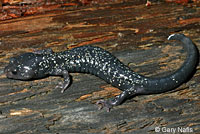 |
Robert Stebbins, in his 2003 Field Guide, mentions a record from Feather River, Butte County that requires confirmation. Is it really a Black Salamander so far out of range; was the specimen incorrectly labelled; or could it be another species? Maybe it's a Hydromantes found in a large gap in the distribution of that genus. The species Aneides flavipuncatus was divided into several species, and the one closest to the Butte County location is now Shasta Black Salamander - Aneides iecanus. |
| Ensatina eschscholtzii klauberi - Large-blotched Ensatina |
No blotched Ensatina have been confirmed from a large part of the Transverse Ranges west of the east side of the San Bernardino Mountains, but Robert Stebbins, in his 2003 Field Guide, mentions reliable sightings of blotched Ensatina reported from Coldbrook Campground below Crystal Lake, and in the vicinity of Bouquet Reservoir in the San Gabriel Mountains. Since tiger salamander larvae were often used as bait by fishermen, so it's possible that a transformed tiger salamander was the salamander found near Bouquet Reservoir that was thought to be a blotched Ensatina. It's also possible they saw an Arboreal Salamander with large spots at either location. |
| White Mountains Salamander | According to Hansen and Shedd: "A 1952 sight record of a salamander from the North Fork of Perry Aiken Canyon at 10,600 ft/3231 m elev. in the remote White Mtns (Inyo Co.) of far eastern CA remains unconfirmed, despite several search efforts in recent decades. If a salamander does occur at high elevation in that range, it is likely be a species of Hydromantes." (Robert W. Hansen and Jackson D. Shedd in California Amphibians and Reptiles, 2025 p. 67.) |
| Mount San Gorgonio Salamanders | Ensatina are known from mid elevations on Mt. San Gorgonio in the San Bernardino Mountains, but According to Stebbins in his 1972 California field guide (page 56) Ensatina have also been found at 10,000 ft. elevation in rocky habitat on Mt. San Gorgonio. I have not been able to find a museum record for this and the location is not mentioned again in Stebbins' 1985 or 2003 field guides, possibly because the specimens were lost or unavailable. His 1985 guide lists an elevation high of 8,000 ft, but the 2003 guide lists a high of 11,000 ft (3,350 m) higher than the Mt. San Gorgonio record. I have a copy of a letter written by Barney Tomberlin, the man who collected the Ensatinas, to Robert Stebbins dated 22 July, 1965. Tomberlin tells Stebbins that in June 1963, when he was on a fire crew buiding a trail on the mountain, he obtained three specimens of Ensatina near the summit of Ten Thousand Foot ridge. It appears from the map that each salamander was found under different boulders that were so large they had to be lifted with large pinch bars. He says "To the best of my remembrance, they were not blotched." The salamanders were sent to the Fort Worth Zoo and they arrived in good condition, but apparently they were lost over time. I hiked up to the location in June 2009 with several other salamander enthusiasts and found the area to be mostly rocks and trees, as you can see in the pictures below which show the general area. During the limited time we had to search the area we found no salamanders of any kind in the area. But that doesn't mean there aren't any there. 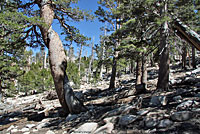  |
| Mystery White Mountains Blotched Salamander | Robert Stebbins, in his 2003 Field Guide, mentions an unconfirmed sight record for a blotched Ensatina in Perry Aiken Canyon on the east side of the White Mountains. It could be a Sierra Nevada Ensatina, or maybe a new Ensatina subspecies, or a new species of Batrachoseps, or even the Owens Valley Hydromantes. The mystery remains. |
| The Trinity Alps Giant Salamander | This one is a favorite of Cryptozoology sites: Unknown Explorers Darksites.com Cryptozoology - (page has been removed) The Cryptid Zoo Wikipedia used to have a page on the subject but it was removed. No specimen has ever been found, but since the 1920s several sources have claimed to have seen very large salamanders in lakes and streams in the Trinity Mountains. It was speculated that they could be related to the Asian Giant Salamanders of the family Cryptobrachidae. They have been variously described as 5 - 9 feet long, as the size of a Hellbender, and as the size of an alligator. One man reported the measurement of one he caught while fishing as 8 feet 4 inches long. The stories were tempting enough to send a number of biologists on expeditions to find them, including Robert C. Stebbins, Thomas Rodgers, and Nathan Cohen in 1960, but they all failed to find any of the gigantic salamanders. In 1997 Kyle Mizokami, who also researches Bigfoot, undertook another expedition but failed to find any of the salamanders. Apparently, after searching for it and failing to find it, Robert C. Stebbins was skeptical of the existence a giant salamander in the Trinity Alps. As told to me in January 2021 by Al-Hajji F. H. Minshall: "On one occasion, while working with both gentlemen [R. C. Stebbins and S. B. Ruth] on the initial population/distribution study for Ambystoma macrodactylum croceum at Ellicott Pond, Aptos, Santa Cruz Co., CA in 1971 Dr. Stebbins mentioned his search for the 'giant salamander'. His conclusion was that the sightings were based on a large, half-sunken, vaguely "salamander-shaped" log." In November, 2022, Jon Hakim sent me a 1962 article from Baltimore Grotto News Vol 5 Issue 1 page 257 that was sent to him by Kim Fleischmann, Sec/Treas, Baltimore Grotto of the NSS, titled "Giant California Cave Salamander Debunked." You can read the article below. The conclusion of the eminent herpetologists is that the only large salamanders found in the lake are Dicamptodon which only grow to about a foot long, rather than the reported 5-9 foot long salamanders. The failure of an expedition to find the salamanders in one location does not prove that they don't exist, but the discovery of the Dicamptodon provides a reasonable explanation for the inaccuracy Griffith's report. (Maybe he saw the large Dicamptodon and some large logs nearby and concluded the logs were also salamanders.) 
|
| Sacramento River Giant Salamander | This is another example from the Cryptozoology sites. Apparently, in 1939 or 1940, a herpetologist named George C. Myers examined a 25 to 30 inch salamander that was caught in a river near Walnut Grove in the net of some fishermen who then kept it in a bathtub. He described it as brown with irregular well-defined yellow spots on the back. Myers described it as a member of the Asian Giant Salamander family. He also mentioned the possibility that it could be an escaped Asian Giant Salamander which were known to have been shipped to the area. (They were most likely shipped as food as they are a popular food in China. Walnut Grove had a large Chinese population until 1915 when its Chinatown burned down and was replaced by a Japanese American community until the people were thrown in prison camps during the second world war.) The Lord Geekington |
| Argus Mountains Salamander | "Darwin Tiemann, a well-known naturalist, reported finding a salamander here [Argus Mountains] in the 1950s or 1960s. It could be a new species." US Dept. of the Interior BLM California Desert Conservation Area. September 1980 Final Environmental Inpact (sic) Statement and Proposed Plan. Appendix. Volume B Appendix III Wilderness Wilderness Study Area 132 - Great Falls Basin ("Wilderness Study Area 132 is located on the eastern slope of the Argus Mountains, adjacent to the China Lake Naval Weapons Center.") Wildlife Page 125 Google Books |
| Frogs | |
Xenopus laevis sp.  |
There has been some speculation that more than one form of Xenopus laevis has been established in California. This has not been confirmed by molecular testing, and all Xenopus laevis found in California so far have been morphologically identical to X. l. laevis. |
| Unique Taxa Once Listed As Present in California that are No Longer Recognized | |
These are not old names for currently-recognized taxa found in California, but unique forms that were once recognized or proposed for recognition and included in publications, but were never officially descrsibed or were not included in future publications. There are likely to be more examples that I have not yet listed here. |
|
| Amphibians | |
Aneides lugubris farallonensis - Farallon Island Arboreal Salamander © Morgan Stickrod © Morgan Stickrod |
Arboreal Salamander - Aneides lugubris Subspecies A. l. farallonensis "...south Farallon Island off San Francisco Bay. Spotting heavy." (Robert Stebbins. Amphibians and Reptiles of Western North America. 1954 p. 80.) |
| Batrachoseps pacificus catalinae - Santa Catalina Slender Salamander |
Pacific Slender Salamander - Batrachoseps pacificus Subspecies Santa Catalina Slender Salamander - B. p. catalinae "Hind limb of adult when extended along side overlaps 3 2/3 to 4 21/2 costal folds; 18 eto 20 costal grooves. Dides of belly with fine black network. Catalina I." (Robert Stebbins. A Field Guide to Western Reptiles and Amphibians. 1966 pp. 46-47) |
| Snakes | |
| Tantilla planiceps transmontana - Desert Black-headed Snake | Western Black-headed Snake - Tantilla planiceps |
| Lampropeltis getula yumensis - Yuma King Snake 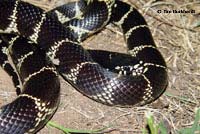 © Tim Burkhardt |
Common Kingsnake - Lampropeltis getulus (Now Lampropeltis californiae) Subspecies Yuma Kingsnake - L. g. yumensis "Brown pigment on the bases of the white scales of the crossbans; narrow white bars on the prefrontals. In se. Arizona, where it meets the Sonora Kingsnake, it occurs in the San Pedro and San Simon Valleys in creosote bush desert." The range map (148) shows this subspecies present along the Colorado River and in extreme southeastern California, apparently from the Peninsular range mountains through the desert and the Imperial Valley to the river. (Robert Stebbins. A Field Guide to Western Reptiles and Amphibians. 1966 pp. 157-158.) |
| Turtles | |
| Clemmys Marmorata - Western Pond Turtle - Afton Canyon Pond Turtle (Now Actinemys pallida - Southwestern Pond Turtle) |
"Species is estimated to be in decline throughout 75-80 percent of its range. ... Afton Canyon population near terminus of Mojave R. neeeds special protection. It may be a distinct taxon. Its habitat should be kept fenced to exclude cattle and off-road vehicles." (Stebbins, Robert C. A Field Guide to Western Reptiles and Amphibians. 3rd Edition, 2003. pp. 249-50) |
Return to the Top
© 2000 -